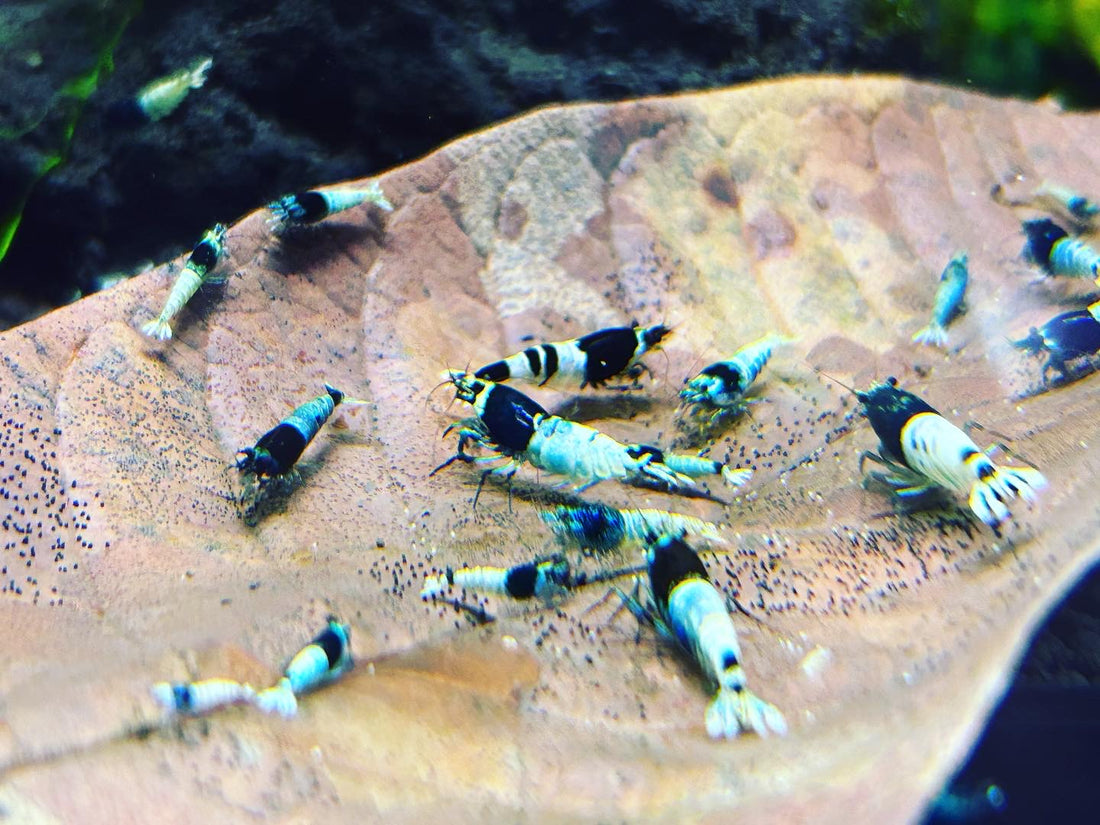
Keeping Caridina Shrimp
Share
Keeping Caridina shrimp is not that dissimilar to keeping the well known Neocaridina Shrimp. As long as a few rules are followed in regards to water parameters and temperature these shrimp can thrive with minimal care needed. With the various assortments of colour and pattern they have become popular amongst aquarium keepers and breeders worldwide.

The most common Caridina shrimp is the crystal red shrimp and the crystal black shrimp. Additionally, in the Caridina family we also include the Tiger shrimp and Taiwan bee shrimp. Through selective breeding, Caridina shrimp have been crossed amongst all variants to give many different colours and patterns.
Caridina Shrimp Variants
Bee Shrimp (Caridina logemanni)
The Bee shrimp is the result of selectively breeding the wild form of bee shrimp.
- Red Crystal
- Black Crystal
- White Crystal
With careful selection the colour can be bred more or less solid to create a Super Crystal Red or Super Crystal Black.
Taiwan Bee Shrimp (Caridina logemanni)
- Ruby Red
- Wine Red
- Black King Kong
- Panda
- Shadow Panda
- Blue Jelly
- Green Hulk
*Note- There are many variables in regards to patterns and grading within these colour variants
Tiger Shrimp (Caridina mariae)
- Red Tiger
- Black Tiger
- Orange Eye Blue Tiger
- Royal blue

*Note- There are many variables in regards to patterns and grading within these colour variants
Tiger Shrimp (Caridina serrata)
- Tangerine Tiger
Tibee Shrimp
A Tibee shrimp is a cross between a tiger shrimp and a Taiwan bee or Crystal bee shrimp. This crossing is useful to strengthen the gene of the Taiwan bee shrimp as a result. Also, the Tibee Shrimp will produce a higher percentage of Taiwan bee shrimp when crossed back to a Taiwan bee again. This cross is called a ‘Taitibee Shrimp'(TB x Tiger x Bee).
Pinto Shrimp
A Pinto shrimp is a result of breeding Taitibee shrimp, these shrimp come in two main colour forms being red and black as well as caring forms of patterns such as Skunk, fishbone, cloud etc.

Caridina Shrimp Water Parameters
As previously mentioned, Caridina shrimp require some specific water parameters.
Water Hardness
As a rule, Caridina shrimp require soft, acidic water with a KH 0-2 and GH 4-6, easily measured by way of a GH/KH Test Kit. To achieve this many keepers employ the use of a Reverse Osmosis Filter to remove ALL hardness from the source water and remineralise with GH+(calcium and magnesium salts) to the required General Hardness.
PH
Its been well documented that Dwarf Bee Shrimp like slightly acidic water below 6.5PH. Most keepers and breeders all agree that this is easiest to maintain with the use of active substrates. Substrates like ADA Amazonia or Master Soil buffer the water to the correct range required.
Additionally, it is worth noting that active substrates do have an expiry. The soil substrate loses the ability to keep the PH down as it ages and may require changing out after 1-2yrs.
Temperature
The tolerable temperature range for Caridina shrimp is 16-24°C although the ideal is 21-23°C. Furthermore, temperature plays a major role in the longevity of the shrimp. At higher temps the shrimp do not live as long or grow as large.
Shrimp Aquarium
Above all, keep the aquarium simple.
Firstly, filtration need only consist of a sponge filter or similar so as not to suck the shrimp through. Maintaining the nitrogen cycle is most important for Caridina shrimp.
Secondly, female shrimp can sometimes be stressed by the males during moulting. For this reason, there should be many hiding spots available. Additionally, it will give places for shrimplets to shelter.
Lastly, a Heater or Chiller to keep the temperature stable depending on your climate.
Feeding
When feeding dwarf aquarium shrimp less is often more. Shrimp will feed off decaying material and biofilm available in the aquarium. In fact, many aquarium keepers do not even directly feed their shrimp. Although, with larger shrimp populations supplemental feeding becomes necessary.
Accordingly, in our home and shop aquariums we feed a varied diet of commercially prepared Shrimp Food for the most part.
Breeding Caridina Shrimp
Evidently, as long as there is a male and female shrimp, they will breed. Females can be distinguished by the deeper body shape. A female will become saddled when mature and ready to breed, this ‘saddle’ is the eggs forming. Subsequently, once fertilised the female will carry the eggs under her tail for 3-4 weeks and generally have approx 20-30 shrimplets each clutch.
Available Shrimp
To Browse our available Caridina Shrimp Click Here